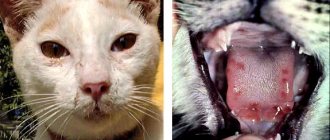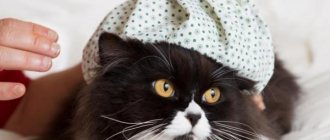What is the conjunctiva and why does it become inflamed?
The surface of the eye is covered with the conjunctiva. This is a thin mucous membrane necessary to moisturize the eyeball. Maintaining the correct level of humidity occurs through the distribution of tear fluid over the entire surface. Any irritation can damage the sensitive membrane. And since there are many nerve endings and blood vessels on it, inflammation and painful sensations immediately occur.
Doctors distinguish different forms of eye conjunctivitis in cats:
- Primary
arising from infection.
- Secondary
which is a symptom of another illness.
- Spicy
, which is characterized by a clear clinical picture of all signs of inflammation.
- Chronic
, proceeding sluggishly for a long time.
Any form of inflammation is well treated. But complete relief from the problem is only possible if you consult a doctor in a timely manner and follow all his recommendations.
Conjunctivitis of bacterial origin
Perhaps bacterial conjunctivitis is even more common than viral conjunctivitis. This group of diseases causes even more problems for cat owners and the animals themselves. The problem is that not only “special” pathogenic bacteria, but even conditionally pathogenic microbes can cause an inflammatory process in the conjunctival cavity. And there are millions of them in the environment. Finding out which microorganism caused conjunctivitis in each specific case is very difficult. But this must be done, because the treatment of inflammation caused by staphylococcus and provoked by a pathogenic strain of E. coli is different. More precisely, the difference is in the price and spectrum of action of antimicrobial drugs used for this purpose.
Clinical picture
In the morning, the cat usually turns out to be like a mole: its eyelids are stuck together with dried pus or catarrhal exudate, and when it tries to open its eyes, the animal experiences severe pain. The pet's eyelids are noticeably swollen and hyperemic . As a rule, within about three days from the onset of infection, the inflammation turns into a purulent form .
If you pull the lower eyelid of the animal towards you, you can see peculiar mucopurulent “threads”. In cases where the animal has not received any medical care for a long time, erosions and ulcerative lesions can be seen on the mucous membranes of the conjunctival cavity. Thus, bacterial conjunctivitis is purulent and has a severe course.
Therapeutic techniques
Considering that conjunctivitis of bacterial origin is highly virulent and contagious (that is, it can spread quickly), a sick animal (if possible and if necessary) should be isolated from still healthy pets.
As a rule, cat diseases are not transmitted to humans, and it is impossible to contract conjunctivitis from a cat, but you should still strictly observe all personal hygiene measures after caring for a sick pet.
If there is no suspicion of chlamydial origin of conjunctivitis, then in most cases the manifestations of the disease can be completely stopped within a week. To do this, use 0.5% drops of moxifloxacin. Frequency of use: three times a day. If within two to three days it is not possible to achieve a pronounced positive result, then the disease may be of viral/allergic origin, and therefore it is necessary to adjust the course of treatment. In such cases, it is also necessary to seed the pathological material , since there is a possibility that the bacterial microflora is insensitive to the selected drugs.
In severe cases (and an abundance of purulent exudate), administration of ceftriaxone (up to a gram intramuscularly) or ciprofloxacin is indicated. The latter is administered at a dose of 15 mg/kg twice a day for five days (depending on the reaction of the cat’s body). If it is not possible to use these drugs, use Levomycetin. At least three times a day it is necessary to apply 1% tetracycline ointment into the conjunctival cavity. If the cat is greatly bothered by the abundant exudate, it must be washed off regularly using warm and sterile saline.
Causes of conjunctivitis in cats' eyes
Many factors can provoke the occurrence and further development of inflammation of the mucous membrane of the eyeball. Subsequent treatment depends on them.
Infections
Microbes, fungi and viruses are the most common sources of pathology. The infection can enter directly into the organ of vision or affect a separate system of internal organs.
Eyes are an indicator of the health of an animal. And any ailment caused by viruses or bacteria necessarily manifests itself in redness and suppuration of the thin membrane.
Injuries and debris
Contact with a foreign body on the conjunctiva causes discomfort in the eye and leads to mechanical damage. And all wounds, wherever they arise, become gateways for infections. A large volume of tear fluid produced can significantly reduce the number of bacteria, but if the damage is severe, inflammation is inevitable.
Chemical exposure
Contact of chemicals or other substances on the mucous membrane leads to terrible burns, causing blindness or even death of the animal. No less dangerous are the chemical fumes that curious individuals inhale. As soon as you leave an open bottle of solvent or a can of paint, a cat or kitten will immediately sniff the pungent-smelling object.
Particularly curious mustaches are interested in packs of washing powder or other household chemicals. Therefore, all chemicals, even seemingly harmless ones, should be hidden from your pet in locked cabinets.
Allergy
The effects of allergens on the human body and the four-legged friend are largely similar. A living creature begins to sneeze, cough, and itchy and flaky areas appear on the body.
In addition, allergies are accompanied by a sore throat and profuse lacrimation; as a result, the mucous membrane begins to swell, turn red and itch very much. To heal, it is important to identify the source of the body’s reaction and eliminate it. In some cases, the veterinarian prescribes antihistamines.
Irradiation
We are talking about different forms of exposure to the pet’s body: ultraviolet, radioactive or x-rays. Lamps with ultraviolet elements, illumination of aquariums and terrariums lead to damage to the retina and inflammatory processes inside the organs of vision. Subsequently, constant exposure to ultraviolet radiation impairs the ability to see and leads to complete or partial blindness.
Infection with worms
Intestinal parasites entering the body lead to a large number of health problems. First of all, it is worth noting the sharp deterioration in the immune system of the infected animal. This contributes to the formation of inflammation and allergies to waste products of worms.
Spread of inflammation from a neighboring area of the body
Diseases of the nasolacrimal ducts and cornea of the eye lead to infection of the mucous membrane. This is due to the interconnectedness of the functions of these departments. Inflammation can also spread from the skin around the eyes.
Prevention of conjunctivitis
- Proper balanced nutrition;
- Limiting contact with foreign animals;
- Proper and daily care of the animal, especially the eyes, ears, nose;
- Visit a veterinarian regularly;
- Get vaccinated;
- Increase immunity;
- Frequently clean the apartment and clean carpets;
- Avoid drafts in the house;
- In frosty weather or strong winds, take the cat out for a maximum of 15 minutes;
- Hide household chemicals and perfumes;
- Do not get into your eyes, ears, or nose with your hands; carry out cleaning procedures with clean hands using cotton pads and cotton swabs;
- Carry out a deworming procedure every 3 months.
In most cases, provide first aid to the cat in a timely manner, get rid of the causes provoking the disease, and follow the rules of keeping and caring for the pet.
Types of pathology
The forms of conjunctivitis in a cat affect the treatment that the veterinarian will prescribe. It is quite difficult to independently determine the type of problem.
Catarrhal
Catarrhal appearance becomes a harbinger of the appearance and development of even more serious eye diseases of the viral type - if it is not stopped immediately. This pathology is not considered dangerous and is most often caused by the penetration of various types of streptococcal and staphylococcal infections into the lacrimal sac. If the owner noticed the problem in time and contacted a veterinarian, then the catarrhal form can be cured in a week.
Allergic
This type can be caused by various allergens: unsuitable food, pollen, dust, household chemicals. So-called “trails of tears” form on the mustachioed friend’s face. They give your pet an unkempt appearance and over time acquire a reddish tint.
Redness and swelling occur due to excessive tearing and subsequent irritation. Most often, breeds with a short muzzle, as well as individuals of white or light colors, suffer from allergic manifestations.
Purulent
Purulent conjunctivitis in cats most often occurs due to mechanical damage and subsequent infection of the wound. It is characterized by the formation of cloudy green pus and crusts in the corners of the eyes.
Gradually, the eyelids become swollen and stick together, and hair falls out around them. In advanced cases, an unpleasant odor is noticeable. Symptoms of the purulent form include high fever, weakness and photophobia.
Follicular
This type of pathology develops due to untimely or improper treatment of catarrhal type. The follicular form is caused by bacteria, fungi and viruses that have entered the organ.
The disease manifests itself not only in redness and swelling, but also in enlarged lymph nodes. The suffering furry constantly squints and blinks more often. All this happens due to spasm of the muscles of the eyelid. A cloudy film is visible on the animal’s eyes, and pus is mixed with the tear secretions.
The eyelids become covered with red bumps called follicles. Because of them, the skin of the eyelids begins to turn outward. The doctor, having assessed the patient’s condition, will immediately prescribe treatment. If you ignore the problem, the animal will go blind.
Viral and fungal
This is the most common type of illness. It is caused by almost any viral or infectious disease caused by pathogens entering the organs of vision. The cat's eyes begin to water heavily, and crusts form due to purulent discharge. If you do not get help, this variant of the disease can become dangerous and lead to further infection.
Phlegmonous
Fortunately, this dangerous variant of the pathology is extremely rare, because it is a consequence of a serious chemical burn. An acid or chemical may get into your cat's eye. In this case, it is almost never possible to save vision, because a complete retinal detachment occurs, and the apple is covered with a cloudy film.
Parenchymatous
The parenchymal type of inflammation affects not only the superficial membrane, but the entire eyeball. Bleeding crusts appear around, the tissue becomes dense, and small tubercles form. The natural color of the mucous membrane changes to a cloudy brown color. Without properly selected drug therapy, the animal becomes completely blind.
Washing
Treatment of conjunctivitis in a cat is best done by a veterinarian. Having noticed the first signs of the disease, you should immediately show the animal to a specialist. In an advanced form or with an acute course of the disease, there is a high probability of developing many serious complications.
But before going to the clinic, you can provide your pet with pre-medical care, which will slightly improve his well-being. The most effective way is to wash the eyes with herbal infusions, such as chamomile or calendula. The liquid should not be too hot or cold. You can also use strong black tea for the procedures.
How to wash a cat's eye with conjunctivitis to quickly overcome the disease? The best option is a solution of furatsilin. To prepare it, you need to dilute 1 gram of the drug in 5 liters of warm boiled water. Some people claim that you can use potassium permanganate, but veterinarians do not advise doing this because it dries out the mucous membrane too much, and in high concentrations it can leave burns.
Another good rinse is boric acid. It is diluted with water at the rate of 1/2 teaspoon per 200 milliliters of water. To relieve pain, two drops of two percent Novocaine are dripped into each eye twice a day. This drug also relieves swelling well.
But don’t stop at just rinsing. Self-medication should not be carried out, as it can distort the clinical picture, which will negatively affect the results of future therapy.
Symptoms of feline conjunctivitis
Before treating conjunctivitis in cats, the veterinarian pays attention to the characteristic clinical picture of the disease. It would be a good idea for the owner of a four-legged friend to know about the main manifestations of the disease in order to contact the clinic in time.
External signs
More than half of infections occur in only one eye. If you do not stop the infection, then in a few days problems will begin with the second eye.
The main signs of pathology include:
- photophobia;
- swelling and redness of the mucous surface;
- the cat's desire to wash his face frequently;
- lethargy and apathy;
- refusal to eat;
- temperature increase;
- crusts around the eyes;
- trails of tears mixed with red discharge;
- pus and stickiness of the eyelids.
All the symptoms of conjunctivitis in cats are not always immediately noticeable, and the doctor prescribes treatment based on the first signs to prevent subsequent complications.
The disease occurs in both adults and newborns with closed eyes. In kittens, infection is noticeable by swollen eyelids and crusts of purulent discharge.
When you need to urgently contact a veterinarian
You should not choose treatment on your own, but you can help your pet before visiting a doctor: just wipe the affected eye with furatsilin solution or strong tea leaves at room temperature. If after two wipes the condition does not improve, show the cat to the doctor - perhaps he needs more serious treatment.
You can’t hesitate if a small (up to 3 months) kitten is sick. In children, some diseases develop rapidly and can lead to death in just a few hours. Therefore, urgent assistance from a veterinarian is necessary in their case.
The main symptoms of inflammation of the conjunctiva
The clinical manifestations of conjunctivitis depend on the course of the disease:
- the acute course is accompanied by the sudden onset and clear clinical signs of inflammation with copious discharge;
- subacute clinical course is slightly weaker than acute;
- The chronic course is characterized by slow development, long course and mild clinical manifestations.
General symptoms of all conjunctivitis in cats:
- inflammation of the mucous membranes in the eyes, their active redness;
- increased lacrimation;
- various types of discharge - from mucous to yellow-green purulent;
- the cat’s constant attempts to “wash” the eye or scratch (rub) it;
- sour eyes after sleep, sticking with dried pus;
- pain when blinking, squinting, fear of light;
- sometimes a cloudy film on the cornea is visible.
By the nature of the eye discharge, you can easily determine the causative agent of the disease with further establishment of the initial cause of inflammation:
- purulent discharge is due to the presence of a bacterial infection;
- serous (cloudy and liquid) discharge accompanies viral infections;
- mucous discharge is usually accompanied by allergic conjunctivitis in cats.
If conjunctivitis is not a primary disease, then the clinical picture will be dominated by the symptoms of another primary disease, and conjunctivitis will become concomitant.
One such example is chlamydial conjunctivitis in cats. Inflammation with feline chlamydia affects not only the organs of vision, but also the entire upper respiratory tract - the throat and nasopharynx. First, one eye becomes red and swollen, and after a few days the second one joins it. Redness progresses to increased blood flow to the conjunctiva. The brightest and most severe clinical symptoms appear between 8-13 days, then the symptoms subside over the next 2-3 weeks. With a weakened immune system, symptoms can persist for a very long time, despite treatment.
The diagnosis of such conjunctivitis is made after laboratory microscopy of discharge from the conjunctiva, during which chlamydia is detected. Treatment will be effective only if this type of bacteria is identified and specific antimicrobial drugs are used.
Diagnostic procedures
After a thorough examination of the patient, the doctor will talk with the owner. The specialist will be interested in changes in the behavior of the furry, the time of appearance of signs of illness, and some nuances in the daily life of the whole family. Further diagnostics include:
- Blood sampling for general and clinical tests.
- Taking a swab from the mucosal surface for laboratory testing to determine the type of infection.
- Determination of sensitivity to antibiotics through culture of eye secretions.
Modern clinics offer biomicroscopy. This research method helps to examine the eyelids, mucous membrane, cornea, iris and part of the lens in a few minutes. Biomicroscopy gives more accurate results, which helps to choose the optimal treatment.
Conjunctivitis of allergic origin
Many people naively believe that allergies are “just” endless rhinitis and tears, a red nose and the inability to go outside when poplars are blooming. In fact, this is an extremely serious pathology, directly related to autoimmune diseases and fraught with very bad consequences, including death.
Pathogenesis and clinical manifestations
An allergy develops when the body responds inadequately to the entry of some antigen into it, and the latter can be all kinds of compounds, including pollen and many medicinal substances. In case of allergies, conjunctival tissues quickly swell due to the action of histamine, and lymphocytic infiltration occurs. In severe cases of an allergic reaction, inflammation develops. This is how allergic conjunctivitis begins. Its symptoms are not much different from the clinical picture of inflammation of viral etiology, but there are still differences:
- It all starts with a sudden allergic reaction.
- After its elimination, the animal’s condition seems to stabilize, but the eyelids and conjunctiva remain somewhat swollen.
- After a few hours, the organs become noticeably red, and the hyperemia gradually intensifies.
- After about a day, pronounced signs of inflammation appear, including copious discharge of exudate.
- If the animal is exposed to the same allergen (for example, eats another portion of food), its condition sharply worsens, the eyes swell so that the animal remains almost blind.
Therapeutic techniques
If you notice the onset of an allergic reaction in time, you can get by with “little blood.” The cat is urgently given a diphenhydramine tablet. It is more convenient to do this if you first crush the medicine to a powder state, mix it with a small amount of water and pour it down the pet’s throat using a syringe.
In general, in other cases the approach is similar: the cat is injected with the same diphenhydramine (but intramuscularly) and other sedatives. If the animal's condition is alarming, medications that stimulate respiratory and cardiac activity (at least caffeine-sodium benzoate) are also indicated. Ideally, it is necessary to identify the allergen that causes such a reaction and reliably protect the animal from its effects, but this can only be done with the help of an experienced veterinarian in a well-equipped clinic.
How to treat conjunctivitis in a cat
To alleviate the condition, the pet needs to be provided with peace and the opportunity to be in a room with dim lighting. In addition, it is extremely important to follow all recommendations from your veterinarian.
Prescribing tablets and injections in difficult cases
Only a doctor can prescribe medications and their dosage. Self-administration of medications can cause a deterioration in the patient's condition.
Therapy depends on the type of disease: in case of an allergic form, antihistamines are used, and if the nature of the disease is viral or infectious, then a course of antibiotics or antivirals helps.
Treatment with tablets or solutions is carried out under the strict supervision of a veterinarian, who, if necessary, discontinues the drug, changes its dosage or prescribes a similar remedy.
Drops and ointments
The use of drops and ointments intended for treating people is strictly prohibited. Many of them cause serious visual impairment in the pet due to too high a concentration of the medicinal substance, and some types lead to blindness. For example, Albucid is not suitable for mustaches, although it helps children and adults.
The following ointments and drops for conjunctivitis in cats, recommended by veterinarians, have worked well:
- "Tsiprovet";
- "Leopard";
- "Iris";
- "Ophthalmosan";
- "Tetracycline".
The use of drops depends on the form and type of virus, infection and complexity of the disease. Usually the solution is prescribed four times a day, 2-3 drops in each eye. The ointment is placed behind the eyelid and lightly massaged without pressing on the apple. It is important to monitor the progress of the disease and, in case of complications, re-visit the veterinary clinic.
Washing
The washing procedure cannot replace full-fledged drug therapy, but it will significantly improve the patient’s condition and speed up his recovery. Also, the diseased eye must be washed before applying the medicinal ointment.
For manipulation, it is recommended to use a 0.02% solution of furatsilin, 0.01% chlorhexidine, or 0.9% saline solution. Rinsing can only be done with clean hands, using sterile means at hand. There are two ways:
- The eyes are wiped with a gauze cloth soaked generously in the solution in the direction from the temple to the nose.
- The composition is carefully poured into the upper outer corner of the eye using a syringe without a needle or pipette. Then blot the remaining liquid with a dry gauze cloth.
At home, the procedure is performed at least 3 times a day. It is more convenient to do this with four hands in order to securely fix the pet and quickly rinse. If everything is done correctly, the animal will notice a significant improvement in its condition.
Is it possible to use folk remedies?
Folk remedies in the form of tinctures and decoctions “cooperate” well with drug therapy. Homemade drugs help only with uncomplicated cases of infection, for example, with the catarrhal type of the disease.
Here are the most common means:
- Rosehip infusion is made from 2 teaspoons of dry raw materials and a glass of water. The mixture is boiled for 5 minutes and left until completely cooled. The animal's mucous membrane is washed with the strained solution.
- Mix Kalanchoe or aloe juice with boiled warm water in a 1:1 ratio and wipe the eyelids with this mixture.
- Dill has an anti-inflammatory effect, so moisten a bandage with freshly squeezed juice and wipe the eyelids.
Folk remedies should be used under the supervision of a specialist, making sure that the pet does not develop an allergy to the medicinal plant. All solutions and decoctions are designed to soften purulent crusts, which facilitates their painless removal, and eliminate itching and pain.
Medications
Treating conjunctivitis in a cat at home is possible, but it will not be very effective. To achieve quick results and make the animal feel better, an integrated approach is required. Therefore, it is better to seek help from a veterinarian who will select the optimal treatment program.
As a rule, it includes the following drugs:
- Painkillers.
- Antibiotics.
- Drops.
- Ointments.
- Corticosteroids.
- Cleaning products.
- In some cases, antimicrobials.
If one eye of an animal turns sour, then both need to be treated. Otherwise, there is a high probability of the infection spreading to the second eye.










